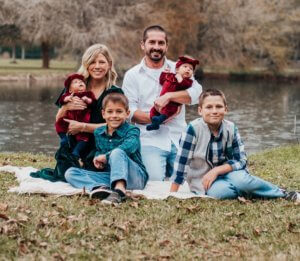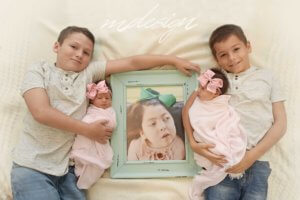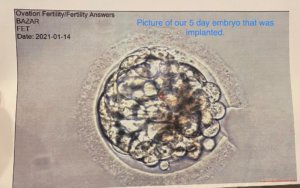Carriers of a rare genetic disease, this Lafayette couple was able to conceive healthy children using IVF with PGT-M

About five months after their third child, Anniston, was born in 2014, Reesa and Corey noticed she was crying a lot, having trouble nursing and unable to hold her head up. On a visit to the pediatrician, Reesa described these symptoms and her pediatrician speculated she had reflux, a common condition among newborns. But after being on reflux medication with no alleviation of symptoms, Reesa knew it had to be something else.
After going back to the pediatrician, he agreed with Reesa and decided to send Anniston to Children’s Hospital in New Orleans to do more extensive testing. It is there that the Lafayette couple discovered that their daughter had a rare genetic disorder called Krabbé Disease. The diagnosis set them on a trajectory that they could have never imagined, a life filled with medical specialists, support groups, state legislators and anguish over a disease they passed to their daughter and had no power to heal.
Parents can unknowingly pass along genetic disorders to their children
Krabbé (crab-ay) Disease, also known as Globoid Cell Leukodystrophy, is a genetic disorder that affects the central and peripheral nervous systems which are responsible for all of the body’s voluntary and involuntary functions. This progressive disease affects the myelin, the insulating sheath that surrounds and protects the nervous system, resulting in a loss of the ability to walk, speak, swallow, cough and more. As Krabbé advances, it encompasses all aspects of bodily function and is fatal for children typically by 2 years of age.

Krabbé Disease is a genetic, or inherited, autosomal recessive disorder. Passing down a genetic disorder is somewhat like a roulette wheel and depends on if both partners are carriers. Since both Reesa and Corey are carriers of Krabbé, something they did not know until Anniston was diagnosed, each child they conceive has either a 50% chance of being an unaffected carrier, just like them; a 25% chance of being affected by the disease, like Anniston; or a 25% chance of neither being a carrier nor affected. Both of their older children, two boys Levi and Liam, have been tested and are also both unaffected carriers of Krabbé Disease.
Embryo genetic testing can determine if an embryo carries a genetic disease mutation
Reesa and Corey always wanted a big family with lots of children. When consulting with the many specialists who helped them navigate Anniston’s disease and care, they learned that it was possible to have more children without the fear of passing such a devastating disease to them. Specifically, they were told that in vitro fertilization with embryo genetic testing for monogenetic disease, PGT-M, could identify which of their embryos have Krabbé Disease, which were carriers, or which were totally unaffected by the disease.

When Anniston was around three-and-a-half years old, Reesa and Corey consulted with Dr. John Storment at Fertility Answers to discuss having more children, but this time using IVF with PGT-M. They knew they couldn’t risk having another child with such a devastating illness. However, they were surprised to learn their health insurance policy would not cover the cost of using IVF with PGT-M embryo genetic testing. “This was so heartbreaking and frustrating,” says Reesa. “Knowing how much suffering my daughter was enduring and how much the insurance company was already paying for her care, it just didn’t make any sense that they wouldn’t pay for a procedure to prevent it from happening again.”
With Anniston’s care becoming more complicated and time-intensive, Reesa and Corey made the decision to put their plan of having another baby on the back burner. As her disease progressed, Anniston was now requiring round-the-clock care, PEG feeding, oxygen, a suction machine and supplemental night nursing. Anniston lived another 2 and a half years, finally passing away April 5, 2020, just three weeks before her 6th birthday. “Krabbé Disease takes so much from a family. Of course, the most obvious is it took Anniston from us,” says Reesa. “However, one thing many people may overlook is that it stole our chance to conceive naturally again.”
IVF with PGT-M helped the couple have children free from Krabbé Disease

Six months after losing Anniston, Reesa and Corey returned to Fertility Answers to resume the process of trying to get pregnant using IVF with PGT-M. Reesa underwent her egg retrieval procedure and fertilization resulting in several high grade embryos suitable for PGT-M genetic testing. They randomly chose eight embryos to biopsy and after two weeks, they anxiously received the embryology call they had been waiting for: 2 embryos were unaffected (didn’t carry any Krabbé mutations), 2 embryos were unaffected carriers, 2 embryos had chromosomal abnormalities, 1 embryo’s results were inconclusive, and 1 embryo was affected with Krabbé Disease.
With this information, Reesa and Corey made the decision to implant one of the totally unaffected embryos in January 2021. Ten days after implantation, Reesa returned to Fertility Answers for a pregnancy test which came back positive. Two days later, more blood work confirmed the pregnancy was viable. At six weeks, she came back for her first OB ultrasound. It was at this appointment that they discovered they had not one baby, but two!
“This is where the true miracle happened and we know God and Anniston played a part in it,” says Reesa. There is about a 2% chance that an embryo will spontaneously split into identical twins resulting from IVF. Reesa believes that this was Anniston’s gift to help her family heal.
The twins, Maeve Anniston and Miley Kate, were born in September 2021, healthy and completely free of Krabbé Disease. “We know Anniston hand-picked them just for us. Our only wish is that they could have met her,” says Reesa.
In their advocacy, the couple has pushed for Krabbé newborn screening in Louisiana through letter writing campaigns and appearing before the Louisiana state legislature. They were successful in getting the Anniston Bazar Act passed in 2016, sponsored by Rep. Julie Emerson. But, while the bill has passed both the Louisiana House and Senate, it has been stuck in limbo for years awaiting approval from the Senate Finance Committee. As of this writing, infants in Louisiana are still not being screened for this deadly disease.


